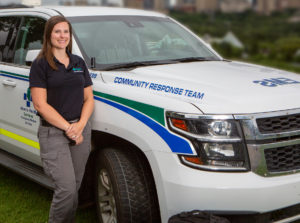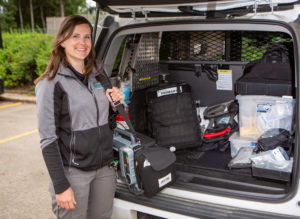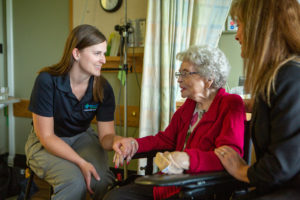Ken Hildebrand once thought of in-home medical attention as a service for elderly patients. That was until he received care in mid-2019 through the Community Paramedic Program.

A shipping supervisor at Greatwest Kenworth Ltd. in Clairmont, Hildebrand had knee replacement surgery last April. An infection took hold shortly afterward and he required multiple daily intravenous (IV) treatments between May and June.
Those treatments would normally have been overwhelming for the family, since Hildebrand was unable to drive the almost half hour from his home in Sexsmith to Grande Prairie between the time of his operation and the completion of his treatment.
The help was greatly appreciated.
– Ken Hildebrand
However, thanks to the Alberta Health Services Community Paramedic Program, he received the treatments in his own home.
“It took a lot of stress off my wife and I since we didn’t need to drive into Grande Prairie three times a day for my IV treatments. With her working, it would have been hard to keep the appointments at 7 a.m., 3 p.m. and 11 p.m. every day for seven weeks” explained Hildebrand, who is in his late 50s. “The help was greatly appreciated.”
To qualify for the service, the patient’s health-care team must determine if the level of care is appropriate. The patient must also have difficulty accessing the care they need due to a physical limitation or a gap in support.

A paramedic responds to each such call, and then works collaboratively with the patient, and their support system, which can include family, friends and/or caregivers. The paramedic connects with the health-care team to develop a plan and provide the necessary care.
“The staff in this program are the most caring and professional,” says Hildebrand. “They came every day with the most positive attitude and really enjoy what they are doing in the communities.”
In the northwest, there are paramedic bases in Grande Prairie and Peace River and service is provided to communities within an 80 km radius of those centres.
Paramedic, Rob Tourangeau, has been part of the community program for about 18 months. Working out of Grande Prairie, he was eager to get on board once he learned how it would benefit patients.
“The patient gets to remain in their residence during treatment,” he notes. “We keep ambulances available for acute emergencies, rather than transporting patients who are capable of being treated at home.
[This is] a great option for people with mobility challenges or for those who don’t feel the need to wait for services that can be provided outside the hospital.
– Dr. Gavin Parker
According to Tourangeau, the treatments that community paramedics provide are the same as most paramedics, ranging from patient assessments and initiating intravenous lines to administering medications and inserting breathing tubes.
“As a community paramedic, we also perform other treatments that can save patients from needing to travel, including inserting or troubleshooting urinary catheters, obtaining blood samples for laboratory testing, ongoing wound care, and suturing,” he adds.
Participating in the program changes how paramedics relate to patients and other health-care providers.

“Being a community paramedic is a very collaborative role and we work as a team with the patient’s doctor, the care facility staff, home care, the patient’s family, and, of course, with the patient,” he explains. “On a regular EMS crew, the medical crew is responsible for directing patient care, while in the Community Paramedic Program, the paramedic is part of that collaborative team.
“Patient care is … our first priority and we focus our days on making those visits to patients,” Tourangeau says, adding that he also responds to emergency calls as they come in.
Dr. Gavin Parker of Pincher Creek became involved in the program about 18 months ago when it expanded into the Lethbridge and Medicine Hat areas.
It was an initiative that he’d already had discussions about establishing in his region, so when the invitation from the Primary Care Network came, he jumped at the opportunity to provide consultation to the health-care team.
“Advanced paramedics have a lot of skills to benefit patients that can reduce some of the strain on hospitals,” he says. “It’s a great option for people with mobility challenges or for those who don’t feel the need to wait for services that can be provided outside the hospital.”
Expansion across the province to provide services to smaller communities will be key as hospitals in the rural areas have fewer resources, Dr. Parker added.
“Leveraging the skills and experience of the paramedics in these communities is not only great for the patients in these locations, but it’s also great for retention of the paramedics. It gives them more breadth and scope in their practice.”
It’s very rewarding.
– Rob Tourangeau
He says the program also helps other health-care providers such as home care nurses be more effective in delivering service, enabling them to help an increased number of people as patient issues are more effectively addressed.
“The paramedics not only assess and treat and dress wounds, but they go to the pharmacy and will get emergency medication coverage for these people, pick up the medicines, and administer it, so it is great for vulnerable people in our population,” says Dr. Parker.
As technology, such as video conferencing capabilities, advance, there will be even more opportunities to capitalize on the program, he says.
“With virtual care, the patient won’t have to travel as much. A paramedic may be able to triage or prioritize people out in the community.”
Paramedic Tourangeau is excited by the emergence of the program.
“This kind of community-based EMS [Emergency Medical Services] program did not exist when I first became an Advanced Care Paramedic. But now that the program is in place, I couldn’t imagine doing anything else,” he concludes.
“It’s very rewarding.”
– David Olinger
